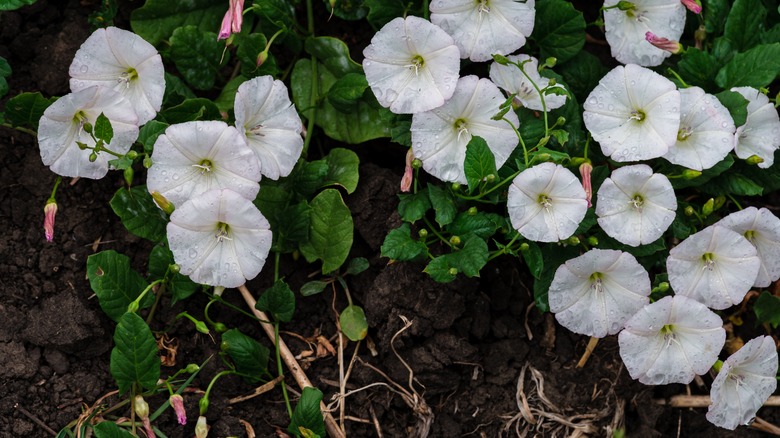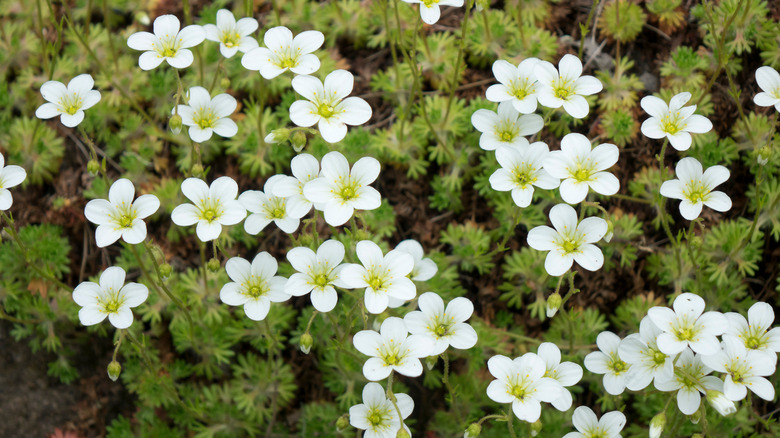15 White Flowering Weeds You Might Find In Your Yard (And If You Need To Pull Them)
You work hard to keep your garden healthy and looking its absolute best. For both new and experienced gardeners, it is helpful to know what to look out for when it comes to protecting the health of your yard. Many different types of weeds could be slowly invading your garden, disguising themselves as harmless white flowers as they take over your lawn and soil. But not all weeds pose the same level of threat. Some weeds may need to be tackled immediately while others are fine being left alone. It's best to know which is which for the safety of your garden.
It's not uncommon for various wildflowers to randomly sprout up in your garden and blend in with the scenery. Some of these include bindweed, stinging nettle, Queen Anne's lace, and mouse-ear chickweed. Being able to identify these flowers is key to curbing a potential issue. It's important to know how to get rid of these harmful weeds and what precautions to take to protect yourself from toxic plants.
1. Bindweed
Bindweed can be identified by elongated trumpet-like flowers. It's important to take notice of this weed, due to how fast and deep it spreads into the ground. Its roots can reach 16 to 20 feet deep into the soil while its sprawling vines intertwine themselves around other plants, choking them and robbing them of their resources. Their strong root system makes them difficult to get rid of since hand pulling only breaks the root, leaving the rest to regenerate. Keep bindweed out of your garden by using herbicides that contain glyphosate to kill the plant through its foliage.
2. White clover
Commonly found in lawns, white clover loves a damp and shady environment. It can be identified by its round white blooms, surrounded by three-leaf (or, if you're lucky, four-leaf) clovers. This weed can be useful to grass because it helps increase nitrogen in the soil and has been used to help with soil erosion, but it is harmful because of how quickly it spreads and takes over your yard. It thrives in nitrogen-poor soil so you can prevent white clover in your yard by fertilizing your lawn to nurture your turfgrass.
3. Queen Anne's lace
Beautiful as its name describes, the white clustered buds of Queen Anne's lace grow on thin stems. This plant thrives in full or partial sun and can grow up to 4 feet tall. While it is lovely, its self-seeding flowers allow it to spread aggressively. Queen Anne's lace can be dangerous as it can cause phytophotodermatitis — a skin reaction caused when its sap contacts skin and is exposed to sunlight. The weed must be uprooted as soon as it's spotted by hand pulling and ensuring the root is removed completely.
4. Japanese knotweed
Japanese knotweed gained popularity as an ornamental plant in the U.S. because of its great relationship with pollinators, but it quickly became invasive due to how quickly it can spread. An invasion can be spotted early by its red, hollow bamboo shoots. You can keep Japanese knotweed from spreading in your garden by cutting the stems to ground level and covering them with a tarp to prevent the plant from getting the sun exposure it needs to thrive. It can take a long time to get rid of and you may need to use herbicides.
5. Stinging Nettle
Stinging nettle is known for its green pointed leaves covered in stinging hairs that produce white and yellow flowers. Some gardeners consider it a weed you may want to grow in your yard because it can be used to make fertilizer, but it can be harmful because it spreads quickly and competes with other plants for water and nutrients. Prevent nettle from spreading by regularly mowing your lawn or cutting the weed back until it weakens and dies. It must be handled with gloves. If the problem persists, you'll have to use herbicide to kill it completely.
6. Daisies
Probably the most harmless-looking weed, daisies produce white-petaled flowers with bright yellow centers and round, flat green leaves. It can spread across your yard quickly, invading the soil and competing with your lawn for nutrients and moisture. This weed isn't just harmful to the health of your lawn, but it's also annoying to get rid of because of its mowing-tolerant and drought-resistant nature. You can get rid of daisies that are taking over your yard by using a daisy grubber, but larger infestations will require multiple herbicide treatments and aftercare to help your lawn recover.
7. Mouse-ear chickweed
Much like daisy weeds, mouse-ear chickweed is commonly found in lawns where it spreads quickly. It can survive close mowing and thrives in various types of soils and climates. This plant can be identified by its small oval leaves that are covered in tiny white hairs that grow around clusters of small, white flowers. Because it has shallow roots that remain close to the soil surface, it can compete with lawns for valuable resources. Despite being mowing-tolerant, mouse-ear chickweed can easily be removed using selective herbicides and keeping up with good lawn maintenance.
8. Wild violet
This flower is divisive. Some gardeners appreciate the flower for its beauty and versatility but others consider it an invasive weed and waste no time in getting rid of it. Wild violets grow in small clusters of white, purple, or blue flowers in short mounds of dense foliage. Because of how fast and quickly it can spread and invade your yard, often returning despite all your efforts to pull it, some gardeners have considered using wild violets as a lawn alternative instead. Smaller weeds can be removed by hand pulling but larger invasions will need repetitive herbicide treatments.
9. Pokeweed
This invasive weed can easily fool an unsuspecting gardener with its striking features. You might be tempted to overlook how invasive and aggressive this weed can be, but it's important to know that every part of this plant is toxic to humans. The weed starts off green, growing a tall and smooth hairless stem where tiny buds will produce small white flowers. These white flowers will turn purple and clusters of juicy berries will grow. Pokeweed's strong root system makes it nearly impossible to get rid of it through hand pulling, but it responds well to herbicides.
10. Pearlwort
Often confused with moss, pearlwort is a fast-spreading, mat-forming invasive weed that produces white flowers on stems surrounded by thin leaves. Because its many flowers grow quickly, the weed's seed spreads easily by air, mowing, and foot traffic. It is very easy for this weed to become a nuisance, and it is very difficult to get rid of. Prevention is better than cure. Keeping your lawn healthy and dense with fertilizer and aeration will make it difficult for its seeds to invade your lawn. Once established, a rigorous herbicide treatment over time might help to kill it.
11. Narrow-leaf plantain
Not to be confused with its more common relative, broad-leaf plantain, narrow-leaf plantain can be seen growing in clumps of 10-inch tall, thin, green, cylindrical stems with tiny hairs that produce tiny white flowers. It is commonly found growing near lawns with sparse, patchy grass. Narrow-leaf plantain isn't harmful, but it can be a bit of a nuisance. If you see it in your yard, you can simply remove it by hand pulling it along with its roots. Prevent the weed from establishing itself by keeping your lawn healthy and dense.
12. Mayweed
The daisy's doppelganger, mayweed also produces white flowers with bright yellow centers. The leaves differ from those of the daisy because of their needle-like appearance. Mayweed is considered a noxious weed because of how aggressive and dominant it becomes, harming other plants around it. Its foliage has been known to cause skin irritation in humans and can be toxic to pets. Small plants must be removed by hand pulling when they are spotted. Wear gloves to avoid skin irritation and safely dispose of the weed where animals can't access it. Larger invasions may need chemical herbicides or professional intervention.
13. Bishop's weed
Much like wild violet, bishop's weed is an invasive plant that is sometimes used as a ground cover. It grows in dense, gorgeous clusters of round white flowers on short, thin stalks. But you shouldn't allow bishop's weed — also known as snow-on-the-mountain — to grow in your backyard if you want your other plants to thrive. It makes a great ground cover because of how it grows to blanket your landscape but it is brutally competitive with other plants. Quickly cut it back and smother the weed for four weeks to be sure you killed it.
14. Jimson weed
Its white trumpet-shaped flowers might have you easily confusing it with bindweed but jimson weed's foliage gives off an unpleasant odor that will set that record straight for you quickly. Jimson weed must be removed from your yard immediately if you find it. This plant is considered invasive and highly toxic to humans, pets, and livestock because of its high levels of alkaloids. Jimson weed can be pulled by hand or dug up to completely remove its roots. Herbicide treatment is needed to treat larger or repetitive outbreaks. Always wear protective gear when dealing with this weed.
15. Yarrow
Yarrow is a common weed that tends to appear if you have a weakened or drought-stressed lawn. It can be identified by white or pink clumps of flowers on stems that creep all over the ground, forming a mat. Its deep roots and underground stems allow it to survive drought and nutrient-deficient conditions while also spreading and invading your grass, robbing it of the little nutrients it has left. Encouraging new grass growth and regular lawn maintenance will strengthen your grass and weaken the weeds. Stubborn yarrow may need repetitive herbicide treatments to get rid of it for good.















